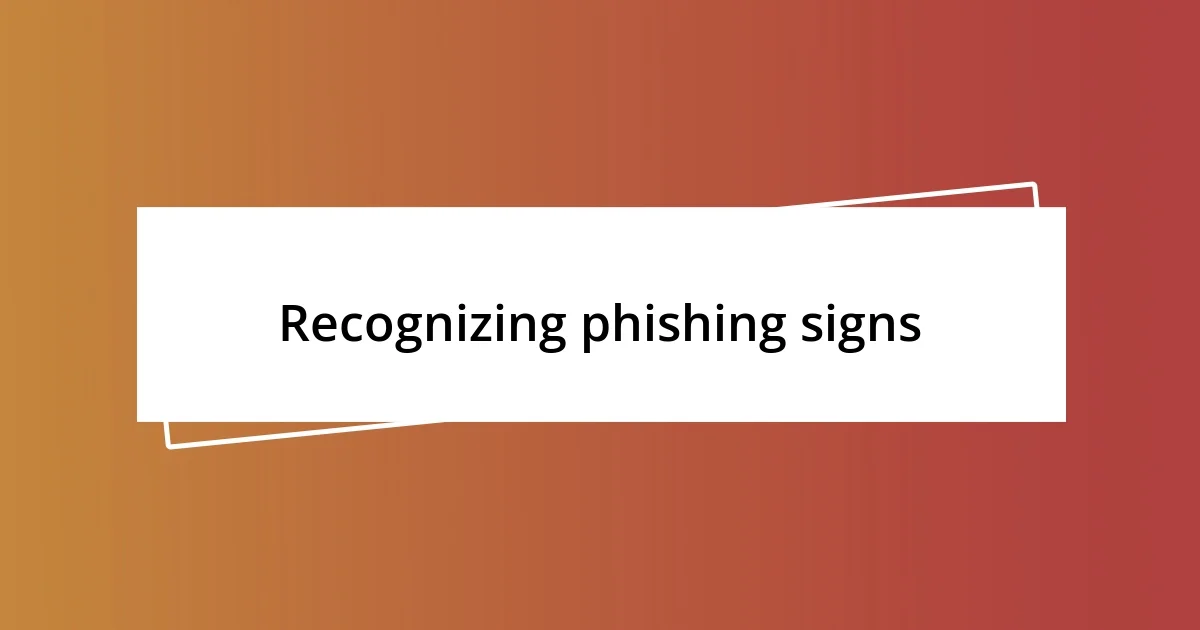Key takeaways:
- Phishing attacks often exploit emotions like urgency and fear, making individuals more susceptible to scams.
- Common phishing techniques include email spoofing, spear phishing, and urgency tactics that can mislead the target.
- Effective prevention strategies involve scrutiny of unexpected communications, keeping software updated, using security tools like password managers and two-factor authentication, and ongoing training and awareness programs.

Understanding phishing attacks
Phishing attacks are surprisingly common, often appearing as innocent emails or texts that mimic legitimate sources. I remember the first time I encountered a phishing attempt; it was an email that looked just like a notification from my bank. I felt a rush of anxiety, realizing how easily someone could trick individuals into revealing sensitive information.
What truly strikes me is the psychological aspect behind these attacks. Phishers often manipulate emotions, creating urgency or fear to prompt quick action. Have you ever received an email claiming your account will be locked unless you verify your information immediately? That sense of urgency can cloud our judgment, making us more vulnerable to falling for such scams.
Understanding the types of phishing attacks, like spear phishing or whaling, can significantly enhance our defenses. It’s often the tailored approach, targeting specific individuals, that makes these attacks so effective. I’ve learned to pause and scrutinize any message that seems too good to be true, asking myself, “What’s the worst that could happen if I don’t respond immediately?” This simple reflection reminds me that taking a moment can be my best line of defense.

Common phishing techniques
Phishing techniques can be as varied as they are deceptive. One common method that I personally find quite troubling is email spoofing. In this case, the sender’s address is disguised to look like a well-known organization. I once received a message that appeared to be from a popular online retailer, encouraging me to claim a discount. Thankfully, something felt off, prompting me to double-check the source. It’s moments like these where that nagging sense of distrust can save you.
Here are some common phishing techniques to be aware of:
- Email Spoofing: Senders mask their email address to appear legitimate.
- Spear Phishing: Targeted attempts at specific individuals, often combining personal information for authenticity.
- Whaling: A more focused attack on high-profile targets like executives.
- Text Message Phishing (Smishing): Using SMS to lure victims into providing sensitive information.
- Voice Phishing (Vishing): Employing phone calls to manipulate and retrieve personal data from victims.
These tactics prey on our instincts and emotions. It’s essential to recognize these patterns, as they serve as a foundation for building our defenses against phishing. When I see these techniques in action, I’m reminded of the strength that vigilance and awareness provide.

Recognizing phishing signs
Recognizing phishing signs can feel tricky, but there are important indicators that can alert us to potential threats. For instance, I once received an email with a glaring misspelling in the sender’s name, which immediately raised my suspicion. It seems like a small detail, but such oversights are often a red flag that signifies a phishing attempt.
One standout sign of phishing that I’ve personally encountered is odd language or wording that doesn’t seem quite right. I remember opening an email that promised incredible winnings, but the phrasing was awkward and unprofessional. It didn’t match the tone of the organization it claimed to represent. A savvy reader can assess these cues and prevent themselves from falling into a trap.
Let’s also not overlook the urgency factor. If you see phrases like “Act now!” or “Your account will be suspended!” it’s wise to take a step back. I recall feeling the heat of pressure with a message demanding immediate action; it turned out to be a scam. This intense feeling we experience with such messages can lead to hasty decisions, so it’s crucial to recognize these signs and maintain a level-headed approach.
| Phishing Signs | Examples |
|---|---|
| Suspicious Email Addresses | Sender’s email may look slightly wrong or unfamiliar. |
| Poor Language and Spelling | Unprofessional wording that is inconsistent with legitimate communication. |
| Urgency or Pressure | Messages demanding immediate action to avoid negative consequences. |

Effective prevention strategies
When it comes to preventing phishing attacks, one of the most effective strategies is to cultivate a habit of scrutiny. I always make it a point to verify the sender of any unexpected email, especially if it includes links or attachments. I can’t tell you how many times I’ve paused before clicking, only to discover that the URL was a cleverly disguised threat. This simple act of checking details can save you from a world of trouble.
Another strategy that I find particularly empowering is keeping software updated. I remember a time when I neglected a software update, only to later discover it included important security patches. In hindsight, it’s clear that those updates weren’t just mundane tasks; they were vital defenses against potential phishing attacks. Keeping systems current does require diligence, but I always remind myself that it’s a small effort compared to the risk of falling victim.
Educating ourselves and others about phishing is also crucial. I’ve participated in workshops that delve into identifying scams, and I can confidently say that sharing knowledge can create a stronger community defense. Have you ever taught a friend how to recognize phishing attempts? It feels rewarding to empower those around you; it’s like creating a safety net. By sharing experiences and strategies, we not only bolster our own defenses but also help to protect our friends and family from similar threats.

Implementing security tools
Implementing the right security tools can make a substantial difference in warding off phishing attempts. I once invested in a reliable antivirus program that included real-time protection against phishing websites. The sense of security it provided was palpable, and on several occasions, I received warnings about sites that I was about to click on—this vigilance became an integral part of my online habits.
Beyond antivirus software, I genuinely can’t stress enough the importance of using a password manager. When I first started using one, I was astonished by how it simplified my life. Not only did it generate complex, unique passwords for all my accounts, but it also helped me recognize when a site was trying to deceive me. Have you ever paused to consider how many passwords you juggle? By centralizing them in a secure tool, I felt more in control and far less vulnerable to phishing schemes.
Two-factor authentication (2FA) is another layer of protection I’ve come to rely on. I remember the first time I enabled 2FA on my email account—despite the extra step, I felt a significant boost in security. It’s a simple act, yet it has shielded my accounts from countless phishing attempts. Considering how validation codes sent to my phone or email add that extra barrier, I can’t help but ask: why wouldn’t you take advantage of this straightforward security measure?

Training and awareness programs
Training and awareness programs are vital for enhancing our defense against phishing attacks. I recall attending a seminar that focused on social engineering tactics—those sneaky methods that attackers use to manipulate individuals into divulging sensitive information. Walking away from that session, I felt enlightened and empowered. Isn’t it interesting how much more vigilant you become when you understand the psychology behind these attacks?
In my experience, regular training sessions can transform how we perceive potential threats at work or even in our personal lives. I participated in a role-playing exercise where we simulated phishing attempts, and it was both eye-opening and a bit fun. Learning to spot the red flags in a playful environment made the information stick. Have you tried such interactive training? It can be a game-changer, fostering a culture of security that everyone embraces together.
I also believe that ongoing awareness shouldn’t just be a one-time event. Making it a part of the workplace culture can reinforce the lessons learned. I often find myself sharing the latest phishing trends with coworkers during lunch breaks. It not only keeps everyone alert but also creates a collective sense of responsibility. When we talk openly about these threats, doesn’t it feel like we’re building a stronger shield against potential attacks? Engaging in conversations about phishing can truly make a difference in how we collectively handle these challenges.

Responding to phishing incidents
When I first experienced a phishing incident, I felt a surge of panic wash over me. My immediate reaction was to freeze, unsure of what steps to take next. I later realized that staying calm and following a response plan is crucial. First, I reported the suspicious email to my IT department, highlighting the importance of quickly notifying professionals who can take further action to protect everyone.
After reporting the incident, I immediately changed my passwords across impacted accounts. I vividly remember how vulnerable I felt when realizing I could be targeted; it was a wake-up call. Trust me, taking that proactive step not only helps secure your information but also provides a sense of control in an otherwise chaotic situation. Have you ever had to change your passwords after a scare? That moment can be freeing as you regain your digital safety.
Reflecting on that experience taught me the value of conducting a thorough review after an incident. I started to assess what information was exposed and whether any financial accounts were at risk. This habit of self-assessment has become integral to how I respond to threats now. It’s fascinating how one incident can entirely shift your perspective, right? Being vigilant not just in prevention but in response has enriched my understanding of online safety.












